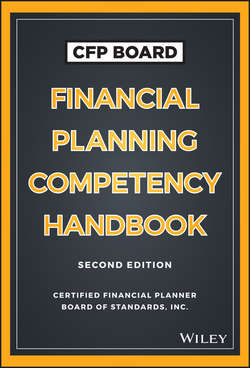Читать книгу CFP Board Financial Planning Competency Handbook - Board CFP - Страница 16
На сайте Литреса книга снята с продажи.
PART One
Introduction
CHAPTER 1
Theory and Practice
PROFESSIONAL PRACTICE CAPABILITIES
ОглавлениеAlmost any individual working within a given profession or occupation, or any other activity for that matter, strives to take the journey from novice to expert. The path to expertise is more than mere education and repetition; rather, it requires individuals to move from a reliance on rules and principles to contextual experiences and to change their perception or understanding of a given context or situation from bits of information to a composite whole.20 The Dreyfus Model of Skill Acquisition is a five-step model that outlines the path from novice to expert relative to these two paradigms. The stages are:
Stage One – Novice: This first stage of skill acquisition is characterized by the novice becoming familiar with a set of features that are recognizable without any experience. These features can be described as context-free or non-situational. In addition, the novice is then given a set of rules that determine actions on the basis of these features. At this stage of skill acquisition, the novice learns to follow these rules consistently.
Stage Two – Advanced Beginner: In the advanced beginner stage, while consistently following the given rules, the student begins to recognize examples of new features that can be effectively identified or learned only through experience. These new situational features are added to the context-free features that the student recognizes, and new rules are introduced that incorporate these examples. The advanced beginner continues to learn to follow given rules in a consistent manner, but is able to incorporate situational as well as non-situational factors when learning and applying these rules.
Stage Three – Competence: At the skill acquisition stage where students attain competence, they have absorbed enough features and rules that attending to all potentially relevant features and analytically applying rules has become overwhelming, and they must develop an approach where they can differentiate among more and less important elements of a situation. Competent performers learn to choose a perspective or formulate a plan that allows them to effectively make decisions by restricting them to only a few of the possibly relevant features of a situation. Through this, competent performers also become emotionally involved in the outcome of their decision making because this outcome depends not only on the adequacy of the rules that they have been given but on their accuracy in choosing a plan or perspective.
Stage Four – Proficiency: At the proficiency stage of skill acquisition, the emotional involvement developed at the competence stage, which strengthens the performer’s ability to distinguish between successful and unsuccessful perspectives, allows the proficient performer to accurately assess situations and choose relevant plans and perspectives. This intuitive situational awareness, though, does not extend to decision making, and proficient performers fall back on the analytic rules they have learned to respond to the goals they have identified and the features that they have identified as being important.
Stage Five – Expert: At the expert stage of skill acquisition, performers then move past the situational awareness that distinguishes the proficient performer to both divide these situations into nuanced subclasses and to attach reactions to them that have, in their experience, been successful. The expert both assesses situations and responds to them intuitively, drawing on his or her vast experience to identify desired outcomes and relevant situational features and also to determine which course of action will be most effective.
In this book, the professional practice capabilities are divided into three levels based on this Dreyfus model – entry-level, competent, and expert – each of which illustrates the financial planning professional’s ability to make appropriate decisions within a complex environment as well as the planner’s progression from strict adherence to rules to use of past experiences to define future action.
The reader is encouraged to use these practice capabilities to both self-assess competency relative to a given concept as well as plan future education and experience that may facilitate a higher level of expertise. Financial planning firms may utilize these capabilities to facilitate formal and informal mentorship programs within their organizations.
20
Stuart E. Dreyfus, “The Five-Stage Model of Adult Skill Acquisition,” Bulletin of Science, Technology & Society 24, no. 3 (2004): 177–181.
